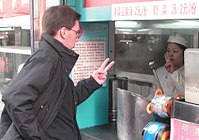
Photo from wikipedia
Gesture recognition based on surface electromyogram (sEMG) signals has drawn significant attention and obtained satisfactory achievement in the field of human-computer interaction. However, the same gesture performed with different arm… Click to show full abstract
Gesture recognition based on surface electromyogram (sEMG) signals has drawn significant attention and obtained satisfactory achievement in the field of human-computer interaction. However, the same gesture performed with different arm positions tends not to generate the same sEMG signals. Traditional solutions can be divided into two types. One type treats the same gesture with different arm positions as the same type, leading to a relatively low classification rate. The other type adopts a gesture classifier followed by the position classifier, which will achieve a satisfactory classification accuracy but at the expenses of high training burdens. To address these issues, we propose a novel framework to explore the intrinsic position independent (PI) characteristics of sEMG signals generated from the same gesture with different arm positions by canonical correlation analysis (CCA), termed as PICCA. In this framework, with the bridge link of the predefined expert set, both the training set and the testing set can be mapped into a unified-style with CCA, and hence, the classification accuracy can be improved in both user-dependent and user-independent manners. Experimental results on 13 gestures with 3 arm positions indicate that the proposed PICCA can achieve higher classification rates than those without CCA (with 28.52% and 44.19% promotions during user-dependent and user-independent manners respectively) while maintaining acceptable training burdens. These improvements will facilitate the practical implementation of myoelectric interfaces.
Journal Title: Computers in biology and medicine
Year Published: 2018
Link to full text (if available)
Share on Social Media: Sign Up to like & get
recommendations!